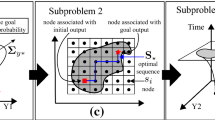Abstract
By using the pseudo minimum translational distance between convex objects, this paper presents two algorithms for robot path planning. First, an analytically tractable potential field is defined in the robot configuration space, and the concept, of virtual obstacles is introduced and incorporated in the path planner to handle the local minima of the potential function. Second, based on the Lipschitz continuity and differentiability of the pseudo minimum translational distance, the flexible-trajectory approach is implemented. Simulation examples are given to show the effectiveness and efficiency of the path planners for both mobile robots and manipulators.
Similar content being viewed by others
References
Latombe, J. C., Robot Motion Planning, Kluwer: Academic Publishers, 1991.
Hwang, Y. K., Ahuja, N., Gross motion planning—A survey, ACM Computer Survey, 1992, 24(3): 219–292.
Lozano-Perez, T., Spatial planning: A configuration space approach, IEEE Trans. Computers, 1983, 32 (2): 108–120.
Brooks, R. A., Lozano-Perez, T., A subdivision algorithm in configuration space for findpath with rotation, IEEE Trans. Systems, Man Cybernetics, 1985, 15(2): 224–233.
Barraquand, J., Latombe, J. C., Robot motion planning: A distributed representation approach, Int. J. Robotics Research, 1991, 10(6): 628–649.
Canny, J. F., The Complexity of Robot Motion Planning, Cambridge: MIT Press, 1988.
Gilbert, E. G., Johnson, D. W., Distance functions and their application to robot path planning in the presence of obstacles, IEEE J. Robotics Automation, 1985, 1 (1): 21–30.
Chen, P. C., Hwang, Y. K., SANDROS: A dynamic graph search algorithm for motion planning, IEEE Trans. Robotics Automation, 1998, 14 (3): 390–403.
Laumond, J. P., Jacobs, P., Taix, M. et al., A motion planner for nonholonomic mobile robots, IEEE Trans. Robotics Automation, RA-10, 1994.
Khatib, O., Real-time obstacle avoidance for manipulators and mobile robots, Int. J. Robotics Research, 1986, 5 (1): 90–98.
Hwang, Y. K., Ahuja, N., Potential field approach to path planning, IEEE Trans. Robotics Automation, 1992, 8 (1): 23–32.
Chuang, J. H., Potential-based modeling of three-dimensional workspace for obstacle avoidance, IEEE Trans. Robotics Automation, 1998, 14(5): 778–785.
Khosla, P., Volpe, R., Superquadric artificial potentials for obstacle avoidance and approach, in Proc. IEEE Int. Conf. Robotics Automation, 1988, 1778–1784.
Koditschek, D. E., Exact robot navigation by means of potential functions: Some topological considerations, In Proc. IEEE Int. Conf. Robotics Automation, 1987, 1–6.
Buckley, C. E., A foundation for the flexible-trajectory approach to numeric path planning, Int. J. Robotics Research, 1989, 8 (3): 44–64.
Zhu, X. Y., Zhu, L. M., Zhong, B. L., Robot collision-free path planning utilizing gauge function, Science in China, Series E, 1997, 40 (5): 546–552.
Xiong, Y. L., Ding, H., General criterion and control strategy of collision-free movement for manipulators, Int. J. Robotics & Automation, 1989, 4(2): 75–80.
Zhu, X. Y., Ding, H., Xiong, Y. L., Pseudo minimum translational distance between convex polyhedra (I)—Definition and properties, Science in China, Series E, 2001, 44(2): 216.
Yuan, Y. X., Sun, W. Y., Theory and Methodology of Optimization (in Chinese), Beijing: Academic Press, 1997.
Author information
Authors and Affiliations
Rights and permissions
About this article
Cite this article
Zhu, X., Ding, H. & Xiong, Y. Pseudo minimum translational distance between convex polyhedra (II). Sci. China Ser. E-Technol. Sci. 44, 337–344 (2001). https://doi.org/10.1007/BF02916684
Received:
Issue Date:
DOI: https://doi.org/10.1007/BF02916684




